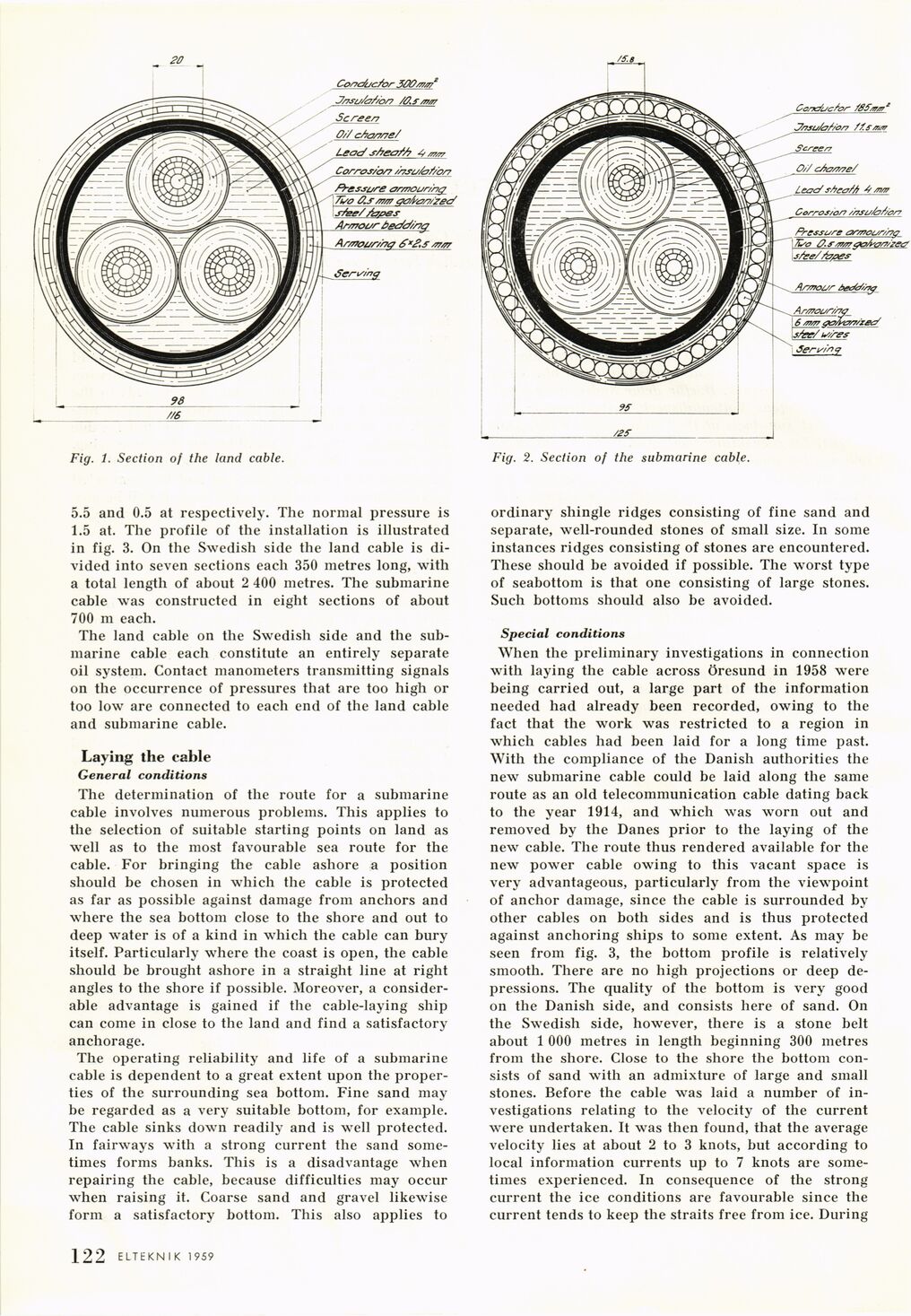
Full resolution (JPEG) - On this page / på denna sida - The Öresund Power Cable of 1958, by Anders Bergman, Wilhelm Carlshem and Gottschalk von Geijer

<< prev. page << föreg. sida << >> nästa sida >> next page >>
Below is the raw OCR text
from the above scanned image.
Do you see an error? Proofread the page now!
Här nedan syns maskintolkade texten från faksimilbilden ovan.
Ser du något fel? Korrekturläs sidan nu!
This page has never been proofread. / Denna sida har aldrig korrekturlästs.
Fig. 1. Section of the land cable.
Fig. 2. Section of the submarine cable.
5.5 and 0.5 at respectively. The normal pressure is
1.5 at. The profile of the installation is illustrated
in fig. 3. On the Swedish side the land cable is
divided into seven sections each 350 metres long, with
a total length of about 2 400 metres. The submarine
cable was constructed in eight sections of about
700 m each.
The land cable on the Swedish side and the
submarine cable each constitute an entirely separate
oil system. Contact manometers transmitting signals
on the occurrence of pressures that are too high or
too low are connected to each end of the land cable
and submarine cable.
Laying the eable
General conditions
The determination of the route for a submarine
cable involves numerous problems. This applies to
the selection of suitable starting points on land as
well as to the most favourable sea route for the
cable. For bringing the cable ashore a position
should be chosen in which the cable is protected
as far as possible against damage from anchors and
where the sea bottom close to the shore and out to
deep water is of a kind in which the cable can bury
itself. Particularly where the coast is open, the cable
should be brought ashore in a straight line at right
angles to the shore if possible. Moreover, a
considerable advantage is gained if the cable-laying ship
can come in close to the land and find a satisfactory
anchorage.
The operating reliability and life of a submarine
cable is dependent to a great extent upon the
properties of the surrounding sea bottom. Fine sand may
be regarded as a very suitable bottom, for example.
The cable sinks down readily and is well protected.
In fairways with a strong current the sand
sometimes forms banks. This is a disadvantage when
repairing the cable, because difficulties may occur
when raising it. Coarse sand and gravel likewise
form a satisfactory bottom. This also applies to
ordinary shingle ridges consisting of fine sand and
separate, well-rounded stones of small size. In some
instances ridges consisting of stones are encountered.
These should be avoided if possible. The worst type
of seabottom is that one consisting of large stones.
Such bottoms should also be avoided.
Special conditions
When the preliminary investigations in connection
with laying the cable across Öresund in 1958 were
being carried out, a large part of the information
needed had already been recorded, owing to the
fact that the work was restricted to a region in
which cables had been laid for a long time past.
With the compliance of the Danish authorities the
new submarine cable could be laid along the same
route as an old telecommunication cable dating back
to the year 1914, and which was worn out and
removed by the Danes prior to the laying of the
new cable. The route thus rendered available for the
new power cable owing to this vacant space is
very advantageous, particularly from the viewpoint
of anchor damage, since the cable is surrounded by
other cables on both sides and is thus protected
against anchoring ships to some extent. As may be
seen from fig. 3, the bottom profile is relatively
smooth. There are no high projections or deep
depressions. The quality of the bottom is very good
on the Danish side, and consists here of sand. On
the Swedish side, however, there is a stone belt
about 1 000 metres in length beginning 300 metres
from the shore. Close to the shore the bottom
consists of sand with an admixture of large and small
stones. Before the cable was laid a number of
investigations relating to the velocity of the current
were undertaken. It was then found, that the average
velocity lies at about 2 to 3 knots, but according to
local information currents up to 7 knots are
sometimes experienced. In consequence of the strong
current the ice conditions are favourable since the
current tends to keep the straits free from ice. During
.122 ELTEKNIK 1959
<< prev. page << föreg. sida << >> nästa sida >> next page >>